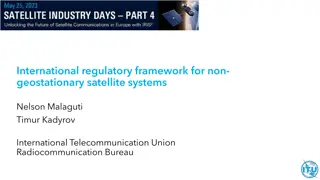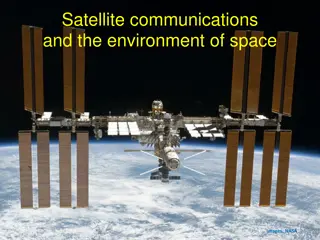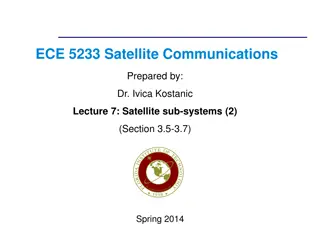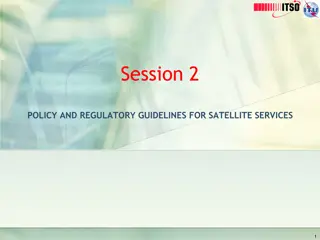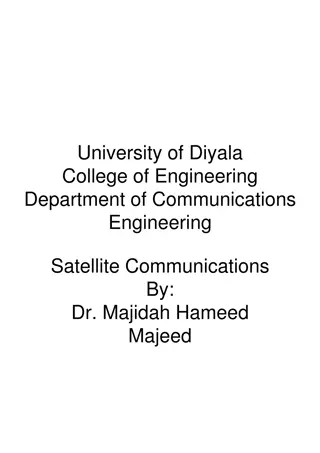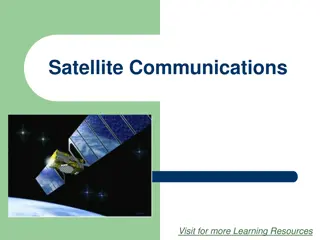Understanding Broadband Communication Systems and Satellite Communications
Broadband communication systems involve the use of satellites for various applications such as TV services, data services, and communication with ships and aircraft. This content delves into orbital mechanics, the gravitational forces in satellite orbits, as well as the orbital heights and velocities of different satellite systems. It explains when to use satellites based on their unique features, cost-effectiveness, and necessity as the only solution. The information provided sheds light on the factors influencing satellite communication performance and the considerations for optimal usage.
- Broadband Communication Systems
- Satellite Communications
- Orbital Mechanics
- Satellite Systems
- Satellite Applications
Download Presentation

Please find below an Image/Link to download the presentation.
The content on the website is provided AS IS for your information and personal use only. It may not be sold, licensed, or shared on other websites without obtaining consent from the author. Download presentation by click this link. If you encounter any issues during the download, it is possible that the publisher has removed the file from their server.
E N D
Presentation Transcript
404190 Broadband Communication Systems
UNIT IV Chap 2-Orbital Mechanics and Launchers History of Satellite communication, Orbital mechanics, Look angle determination, Orbital perturbations, Orbital determination, Launchers and launch vehicles, Orbital effects in communication system performance FDP-BCS-Dec 18-RGP 2
When to use Satellites When the unique features of satellite communications make it attractive When the costs are lower than terrestrial routing When it is the only solution Examples: Communications to ships and aircraft (especially safety communications) TV services - contribution links, direct to cable head, direct to home Data services - private networks Overload traffic Delaying terrestrial investments 1 for N diversity Special events FDP-BCS-Dec 18-RGP 3
Gravitational force is (FIN, the centripetal force) s inversely proportional to the square of the distance between the centers of satellite and the earth. The gravitational force inward is directed toward the center of gravity of the earth. The kinetic energy of the satellite (FOUT, the centrifugal force) is directed diametrically opposite to the gravitational force. is proportional to the square of the velocity of the satellite. FDP-BCS-Dec 18-RGP 4
= F F IN OUT 2 v = m m 2 r r GM = universal = where G gravitatio constant nal E Mass = M of earth E = 5 3 2 Kepler' constant s . 3 986 10 / km s velocity of satellite in a circular orbit is given by 1 Vis inversely proportional to r 2 = v r distance = of the satellite s ' orbit will T be period velocity 5 Ref slide 30
period of the satellite' orbit s will T be ( ) ( ) distance 2 r 2 r = = = T 1 velocity v 2 r 3 2 r 2 = T 1 2 Tis proportional to r FDP-BCS-Dec 18-RGP 6
Orbital Height (Km) 35,786.03 10255 1469 780 Orbital Velocity (Km/s) Orbital period hr. Min. Sec Satellite System 1 2 3 4 Intesat(GEO) New ICO(MEO) Skybridge(LEO) Iridium(LEO) 3.0747 4.8954 7.1272 7.4624 23 56 4.1 5 55 45.5 1 55 17.8 1 40 27 FDP-BCS-Dec 18-RGP 7
. A Cartesian coordinate system with the geographical axes of the earth as the principal axis The rotational axis of the earth is about the axis cz, where c is the center of the earth and cz passes through the geographic north pole. Axes cx, cy, and cz are mutually orthogonal axes, with cx and cy passing through the earth s geographic equator. The vector r locates the moving satellite with respect to the center of the earth. FDP-BCS-Dec 18-RGP 8
Orbital plane coordinate system. The orbital plane of the satellite is the reference plane. The orthogonal axes, x0 and y0 lie in the orbital plane. The third axis, z0, is perpendicular to the orbital plane. The geographical z-axis of the earth (passing through the true North Pole and the center of the earth, c) does not lie in the same direction as the z0 axis except for satellite orbits that are exactly in the plane of the geographical equator. FDP-BCS-Dec 18-RGP 9
Polar coordinate system in the plane of the satellites orbit. The plane of the orbit coincides with the plane of the paper. The axis z0 is straight out of the paper from the center of the earth, and is normal to the plane of the satellite s orbit. The satellite s position is described in terms of the radius from the center of the earth r0 and the angle this radius makes with the x0 axis, o. FDP-BCS-Dec 18-RGP 10
Keplers three laws of Planetary Motion 1. The orbit of any smaller body about a larger body is always an ellipse with centre of mass of larger body as one of the two foci. 2. The orbit of the smaller body sweeps out equal areas in equal time FDP-BCS-Dec 18-RGP 11
Keplers laws If t1 t2 = t3 t4, then A12 = A34. FDP-BCS-Dec 18-RGP 12
3. The square of the period of revolution of smaller body about larger body equals constant multiplied by third power of semi major axis of the orbital ellipse. ( ) 2 3 4 a = 2 T T orbital period a semimajor axis Kepler' s constant If orbit circular, is a becomes (radius r of the circle) 13
The degree to which an ellipse is stretched is described as the eccentricity of the ellipse. The eccentricity can be described as the ratio between the length of the major axis and the distance between the foci of the ellipse. The foci in highly eccentric ellipse are spread farther apart than those of an ellipse with a lower eccentricity. The value of eccentricity ranges from 0 (a perfect circle) and approaches a value of 1 as the ellipse becomes more eccentric. eccentric. A satellite's orbit around the Earth is in the shape of an ellipse, and the Earth's center of mass is at one of the focal points of the ellipse. A satellite orbit can be described by the eccentricity of the orbit. Satellite orbits range from nearly circular orbits (with a low eccentricity) to very highly elliptical orbits (with a high eccentricity). A satellite with a nearly circular orbit maintains a relatively constant altitude above the Earth's surface, while the altitude of a satellite with a very highly elliptical orbit is constantly changing FDP-BCS-Dec 18-RGP 14
Geostationary Geosynchronous 1. (circular orbit) 2. ------------ Correct orbital period ( correct altitude ) ----------- 3. Must be in the plane of the equator Zero Eccentricity 1 Non zero Eccentricity 3 Appear to oscillate around mean look angle in the sky FDP-BCS-Dec 18-RGP 15
Geosynchronous satellite would appear from the equator to wander first north, and then south and then back again over a 24 hour period. FDP-BCS-Dec 18-RGP 16
A geostationary orbit has a radius of around 42,000 km (over 6 times the radius of the Earth) i.e. at a height above the Earth s surface of around 36 000 km. Earth About 6R satellite FDP-BCS-Dec 18-RGP 17
What is Polarisation? Polarization is the property of electromagnetic waves that describes the direction of the transverse electric field. Since electromagnetic waves consist of an electric and a magnetic field vibrating at right angles to each other. it is necessary to adopt a convention to determine the polarization of the signal. Conventionally, the magnetic field is ignored and the plane of the electric field is used. FDP-BCS-Dec 18-RGP 18
Types of Polarisation Linear Polarisation (horizontal or vertical): the two orthogonal components of the electric field are in phase; The direction of the line in the plane depends on the relative amplitudes of the two components. Circular Polarisation: The two components are exactly 90 out of phase and have exactly the same amplitude. Elliptical Polarisation: All other cases. Linear Polarisation Circular Polarisation Elliptical Polarisation FDP-BCS-Dec 18-RGP 19
Satellite Communications Alternating vertical and horizontal polarisation is widely used on satellite communications This reduces interference between programs on the same frequency band transmitted from adjacent satellites (One uses vertical, the next horizontal) Allows for reduced angular separation between the satellites. Information Resources for Telecommunication Professionals [www.mlesat.com] FDP-BCS-Dec 18-RGP 20
The geocentric equatorial system. This geocentric system has the xi axis points to the first point of Aries. The first point of Aries is the direction of a line from the center of the earth through the center of the sun at the vernal equinox (about March 21 in the Northern Hemisphere), the instant when the subsolar point crosses the equator from south to north. In the above system, an object may be located by its right ascension RA and its declination . FDP-BCS-Dec 18-RGP 21
Locating the orbit in the geocentric equatorial system. The satellite penetrates the equatorial plane (while moving in the positive z direction) at the ascending node. The right ascension of the ascending node is and the inclination i is the angle between the equatorial plane and the orbital plane. Angle , measured in the orbital plane, locates the perigee with respect to the equatorial plane. FDP-BCS-Dec 18-RGP 22
Angular distance measured eastwards in the equatorial plane from the xi axis is called right ascension RA. The two points at which the orbit penetrates equatorial plane are called Ascending & Descending node. The right ascension of the ascending node is The inclination iis the angle between the equatorial plane and the orbital plane The angle measured along the orbit from ascending node to the perigee is w (argument of perigee west) FDP-BCS-Dec 18-RGP 23
Zenith and nadir pointing directions. An observer at the subsatellite point would see the satellite at zenith (i.e., at an elevation angle of 90 ). If the beam from the satellite antenna is to be pointed at a location on the earth that is not at the subsatellite point, the pointing direction is defined by the angle away from nadir. In general, two off-nadir angles are given: the number of degrees north (or south) from nadir and the number of degrees east (or west) from nadir. East, west, north, and south directions are those defined by the geography of the earth. FDP-BCS-Dec 18-RGP 24
Question 1. Explain what the terms centrifugal and centripetal mean with regard to a satellite in orbit around the earth. A satellite is in a circular orbit around the earth. The altitude of the satellite s orbit above the surface of the earth is 1,400 km. (i) What are the centripetal and centrifugal accelerations acting on the satellite in its orbit? Give your answer in m/s2 (ii) What is the velocity of the satellite in this orbit? Give your answer in km/s. (iii) What is the orbital period of the satellite in this orbit? Give your answer in hours, minutes, and seconds. Note: assume the average radius of the earth is 6,378.137 km and Kepler s constant has the value 3.986004418 105 km3/s2 Refslide 5 FDP-BCS-Dec 18-RGP 25
Answer Acceleration a = 6.5885007 m/s2 (i) (i) (centripetal acceleration a = /r2, ) Velocity of = 7.1586494 km/s (ii) Orbital period T = 6,826.912916 s = 1 hour 53 minutes 46.92 seconds (v = ( /r)1/2) FDP-BCS-Dec 18-RGP 26
Question 2 A satellite is in a 322 km high circular orbit. Determine: a. The orbital angular velocity in radians per second; = 2 /T b. The orbital period in minutes; and T = (2 r3/2)/( 1/2) c. The orbital velocity in meters per second. v = ( /r)1/2 Note: assume the average radius of the earth is 6,378.137 km and Kepler s constant has the value 3.986004418 * 105 km3/s2. FDP-BCS-Dec 18-RGP 27
Answer (c) The orbital velocity = 7.713066 km/s = 7,713.066 m/s. (b) T = 5,458.037372 seconds = 90.9672895 minutes = 90.97 minutes. (a) The orbital angular velocity as 2 /5,458.037372 radians/s = 0.0011512 radians/s. FDP-BCS-Dec 18-RGP 28
Use Keplers third law, T2 r3, to answer this question. Two Earth satellites, A and B, orbit at radii of 7.0 106 m and 2.8 107 m respectively. Which satellite has the longer period of orbit? What is the ratio of orbital radii for the two satellites? What, therefore, is the ratio of the cubes of the orbital radii? What, therefore, is the ratio of the squares of the orbital periods? Finally therefore, what is the ratio of the satellites orbital periods? 1. Data required: G = 6.67 10-11 N m2 kg-2 mass of Jupiter = 1.9 1027 kg radius of Jupiter = 7.2 107 m Jupiter s day length = 10 hours A satellite is placed in jovi-stationary orbit around Jupiter (the same as geostationary, but around Jupiter, not Earth). What orbital period would it need? What orbital radius would this correspond to? r3 = (GM/4 2) T2 2. FDP-BCS-Dec 18-RGP 29
Solution 1 By Kepler s third law, orbital period increases with orbital radius. Thus B has the longer orbital period. rB/rA = 2.8 x 107/ 7.0 x 106 = 4 (rB/rA)3 = 43 = 64 By Kepler s third law, (TB/TA)2 = (rB/rA)3 = 64 Thus TB/TA = square root of 64 = 8 FDP-BCS-Dec 18-RGP 30
Question 3. A satellite is in an elliptical orbit with a perigee of 1000 km & an apogee of 4000 km. Radius of the earth is 6378.14 km . Find the period of the orbit in hrs. min. & sec. & the eccentricity of the orbit. T = (2 a3/2)/( 1/2) = + a r h h 2 2 = 17,756.28 km + e p a T = 8325.1864 s = 2 h.18 m. 45.19 s Slide 21 31
= ro a e E 1 ( cos ) E = 0 at perigee & cos E = 1 + = r h 1 ( a e ) e p e = 0.169 32
Latitude 2.There are +/- 900 of latitude ,plus being measured north of equator & minus being to the south of equator Longitude line (measured from 00 at GREENWICH meridian) 2. There are 3600 of latitude. 1.Angular distance measured in degrees, north or south of the equator 1.Angular distance measured in degrees, from a given reference longitudinal 33
The latitude and longitude of India in South Asia is 21.7679 N, 78.8718 E. These are known as coordinates. 18.5203 N, 73.8567 E Pune, Coordinates FDP-BCS-Dec 18-RGP 34
Look Angle determination 1. The coordinates to which earth station antenna must be pointed, to communicate with the satellite are called look angles The azimuth (Az) is measured eastwards (clockwise) from geographic north to the projection satellite path on locally horizontal plane at earth station. Elevation (El) is the angle measured upwards from local horizontal plane at earth station to satellite path The subsatellite point is the location on surface of the earth that lies directly between the satellite & the centre of earth 2. 3. 4. FDP-BCS-Dec 18-RGP 35
The definition of elevation (EI) and azimuth (Az). The elevation angle is measured upward from the local horizontal at the earth station and the azimuth angle is measured from the true north in an (clockwise) eastward direction to the projection of the satellite path onto the local horizontal plane. FDP-BCS-Dec 18-RGP 36
The geometry of elevation angle The plane of the paper is the plane defined by the center of the earth, the satellite, and the earth station. The central angle is . The elevation angle EI is measured upward from the local horizontal at the earth station. FDP-BCS-Dec 18-RGP 37
Elevation angle calculation = + cos( ) cos( ) cos( ) cos( ) sin( ) sin( ) L L l l L L e s s e e s = L earth station latitude in degrees (north or south from equator) e = l earth station longitude in degrees (west or east from Greenwich meridian) e = L latitude of subsatelli te point in degrees (north or south from equator) s in = L l l cos( ) cos( degrees ) cos( ) e s e longitude = l of subsatelli te point (west or east from Greenwich meridian) s For most geostationary satellites ,the sub satellite point is on the equator at longitude ls & latitude Ls is 0 . FDP-BCS-Dec 18-RGP 38
The laws of cosines gives 1 2 2 r r = + d r 1 2 cos( ) e e s r r s s since local horizontal plane at the earth station perpendicu is lar to r e elevation angle is El given by = 0 El - 90 which yields sin( d ) r = cos( ) by law of sines s El sin( ) = putting rs=42164.17km re=6378.137km 1 2 2 r r + 1 2 cos( ) e e r r s s 39
Look angle calculation (geostationary satellites) Elevation angle earth at station . 6 6107345 cos( ) = 1 tan El sin( ) The intermedia angle te is derived as ( ) tan l l s e = 1 tan sin( ) L e 0 permits correct 90 quadrant to be found FDP-BCS-Dec 18-RGP 40
Azimuth look angle Az can be found Case 1: Earth station in Northern Hemisphere Satellite to the SE of earth station Az = 1800 - Satellite to the SW of earth station Az = 1800 + Case 2: Earth station in Southern Hemisphere Satellite to the NE of earth station Az = Satellite to the NW of earth station Az = 3600 - FDP-BCS-Dec 18-RGP 41
The geometry of the visibility calculation. The satellite is said to be visible from the earth station if the elevation angle EI is positive. This requires that the orbital radius rs be greater than the ratio re/cos( ), where re is the radius of the earth and is the central angle. For a satellite to be visible from an earth station elevation angle El must be above some min. value r 1 e cos r s = 81.30 For geostationary satellite to be visible FDP-BCS-Dec 18-RGP 42
Question 4. Determine look angles for Earth station latitude & longitude are 52.00 N & 00 Satellite longitude is 66.00 E = L l l . 1 cos( ) cos( ) cos( ) e s e = 75.49810 (Satellite is visible from earth staion) 6107345 . 6 cos( ) = 1 El . 3 tan sin( ) = 5.8470 43
( ) l l tan s e = 1 . 3 tan L sin( ) e = 70.6670 Satellite is to the southeast of the earth station Az = 180- = 109.3330 FDP-BCS-Dec 18-RGP 44
1. 50 at C band, 100 at Ku band,200 at Ku band Small elevation angles for 1.high altitude regions 2. extreme east & west coverage Inclined orbit satellites (with EODL &EOML) 1.Beyond normal lifespan of a satellite 2. Tracking antennas Orbital perturbations 1. asymmetry of gravitational force 2. Stable points 750 E & 2520 E 3. Unstable points 1620 E & 3480 E Effects of Sun & Moon FDP-BCS-Dec 18-RGP Elevation angle minima 45
Figure 2.14 (p. 40) Relationship between the orbital planes of the sun, moon, and earth. The plane of the earth s orbit around the sun is the ecliptic. The geostationary orbit plane (the earth s equatorial plane) is about 23 out of the ecliptic, and leads to maximum out-of- geostationary-orbit-lane forces at the solstice periods (approximately June 21 and December 21). The orbit of the moon is inclined about 5 to the earth s equatorial plane. The moon revolves around the earth in 27.3 days, the earth (and the geostationary satellite) rotates once about 24 h, and the earth revolves around the sun every 365.25 days. In addition, the sun which has a greater girth at the equator than at the poles has its equator inclined about 7.3 to the ecliptic. All of these various angular differences and orbital periods lead to conditions where all of the out-of-plane gravitational forces are in one direction with respect to the equatorial (geostationary orbital) plane at a given time as well as to conditions where the various gravitational out-of-plane forces partially cancel each other out. The precessional forces that cause the inclination of the geostationary satellite s orbit to move away from the equatorial plane therefore vary with time. See next slide for an enlarged image. 47 FDP-BCS-Dec 18-RGP
Figure 2.14 (p. 40) 48 FDP-BCS-Dec 18-RGP
Figure 2.15 (p. 43) Schematic of a Proton launch (after reference 5). 49 FDP-BCS-Dec 18-RGP
Figure 2.16 (p. 45) Representative ELVs (after reference 5). CCAS, Cape Canaveral Air Station; VAFB, Vandenburg Air Force Base. 50 FDP-BCS-Dec 18-RGP



